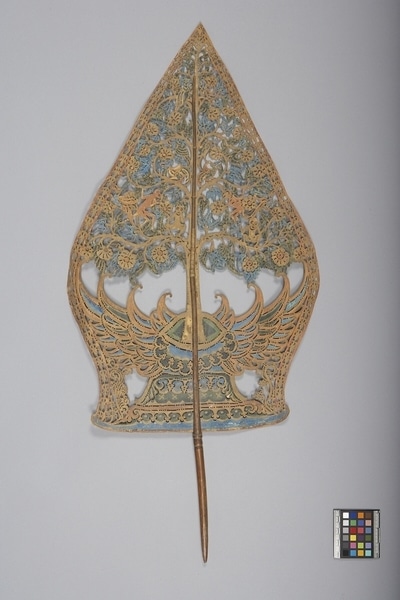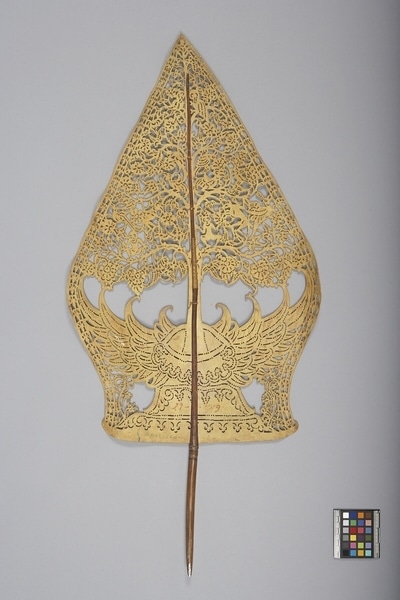Shadow Puppet Item Number: Ib322 from the MOA: University of British Columbia


Description
Wayang kulit (shadow puppet) Gunungan (mountain) or kayon (tree of life). Leaf-shaped filigree-cut leather object tied between stick split lengthwise with 3 carved bands at base and tapering handle. Base of leaf tapers out and into point at top. Light blue pedestal design at base, ends curled up; topped by upturned row of floral motifs. Oval enclosures in centre flanked by 2 large curved wings. Tree trunk grows from oval supporting rosettes, symmetrical sets of branches with 4 monkeys. Six birds in various positions between. All colours pale. Number on base (29-1919 ?) and inscription 'Bakoendean'.
History Of Use
Javanese puppetry as an art form probably developed by the 11th century. The three-dimensional wooden wayang golek puppets of western Java, which are to be distinguished from the earlier and more sacred wayang kulit shadow plays puppets or other forms, appeared during the 16th century. Originally the plays depicted Javanese mythology, but after the Indian conquest of Java the Hindu epics, Ramayana and Mahabharata, were incorporated into the cycles, which comprise about 200 plays. An individual or group hires a dalang (puppet-master) to celebrate important occasions. The performances often last all night and are generally presented in three acts, with vocal and instrumental accompaniment. The individual plays vary widely in detail but usually involve conflict between good and evil. They serve a moral and religious purpose, and more recently, one of political commentary. Each puppet's character is represented by its appearance and placement onstage; protagonists with strong elements of good are placed to the right, antagonists of violent or evil nature to the left. A kayon is an integral part of the wayang, found in all stories. It indicates the elements of fire, water, earth, and sky; symbolizing time and space: used most importantly in introduction, change of scene, and conclusions of plays.
Iconographic Meaning
A 'kayon', identified by its outline resembling a mountain or tree tapering to the top. Upper half represents the natural world of animals in a forest or tree-of-life. Lower part is the supernatural world with the dwelling where the gods reside, sometimes guarded by two demons, lions, oxen, and the mythical bird, Garuda, indicated by the two wings.
Cultural Context
Theatrical performance.
Item History
- Made in Java, Indonesia
- Owned by Tradewind Antiques before March 15, 1983
- Received from Museum of Anthropology Shop Volunteers (Funding source) and Tradewind Antiques (Seller) on March 15, 1983
What
- Name
- Shadow Puppet
- Identification Number
- Ib322
- Type of Item
- puppet
- Material
- leather skin, bamboo grass ?, paint and fibre
- Manufacturing Technique
- cut, carved, painted and tied
- Overall
- height 92.0 cm, width 44.4 cm
Who
- Culture
- Javanese
- Previous Owner
- Tradewind Antiques
- Received from
- Museum of Anthropology Shop Volunteers (Funding source) and Tradewind Antiques (Seller)
Where
- Holding Institution
- MOA: University of British Columbia
- Made in
- Java, Indonesia
When
- Ownership Date
- before March 15, 1983
- Acquisition Date
- on March 15, 1983
Other
- Condition
- fair
- Accession Number
- 0886/0056